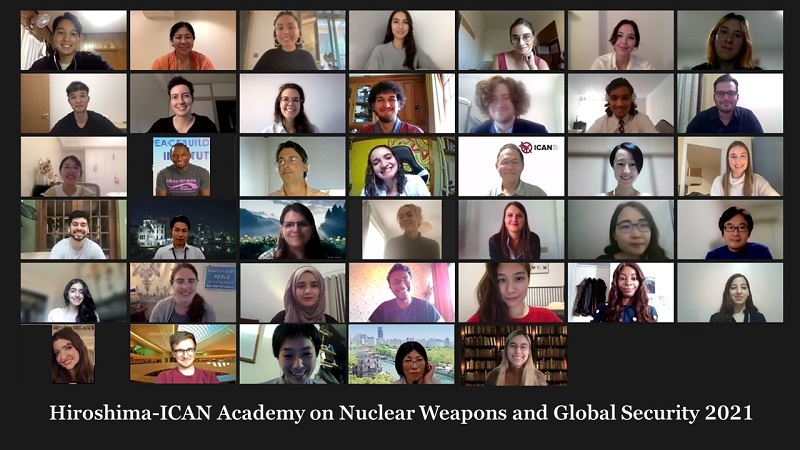
News
More important than ever to learn from Hiroshima: the Hiroshima-ICAN Academy Special Program
The Hiroshima-ICAN Academy Special Program for participants of the Academy in both 2020 and 2021 was held online on March 13 and 14, 2022. This Special Program consisted of online testimonies by Hibakusha (A-bomb survivors) and a virtual tour of A-bombed remains and the Peace Museum in Hiroshima, enabling participants to see the humanitarian consequences of the use of nuclear weapons. This special online program took the place of an in-person training, which had been originally planned as Part 2 of the Academy. As an International Steering Group member of the International Campaign to Abolish Nuclear Weapons (ICAN), Peace Boat played a central role in the planning and organization of the Academy.
Day 1: Listening directly from Hibakusha about what it was like to be in the city of Hiroshima on August 6, 1945

The first day of the program included Q&A sessions with two Hibakusha - Mr Lee Jongkeun and Ms Kiriake Chieko - as well as a live visit to Hiroshima’s largest surviving A-bombed building, the Army Clothing Depot.
Mr Lee Jongkeun, a Hibakusha of Korean descent, shared his experience from the Kojin bridge where he was exposed to the atomic bombing. In his testimony, he also spoke of the discrimination and hardships he faced due to his dual identities. Participants learned about the location of the bridge through a virtual map, and felt the living atmosphere at the bridge with trains and pedestrians passing by.
After exploring the sites and hearing a briefing about their history, participants then virtually met Ms Kiriake Chieko, who was 16 years old in 1945. Ms Kiriake shared how the huge Army Clothing Depot, where her mother had worked, became filled with the wounded and dead following the bombing.
The Special Program took place just as it was just reported that the Chernobyl Nuclear Power Plant in Ukraine was under attack by the Russian military. Mr Lee shared, “I feel so sad when I think what would happen if the Chernobyl nuclear power plant were to explode because of an attack. When I remember what I experienced due to the atomic bombing, I am certain that we must eliminate nuclear weapons from this world.”
Day 2: Virtually visiting the Hiroshima Peace Memorial Museum and Park

These two well-known sites in contemporary Hiroshima receive many thousands of visitors per year. Yet before the bombing, the area was a bustling shopping and residential district called Nakajima-cho. This area was completely wiped out on August 6, 1945.
The virtual tour focused on not only how the bombing affected Hiroshima and its people, but also how the city has chosen to memorialize what happened and share its stories with others.
In the Museum, participants were guided to see artifacts damaged by the atomic bomb, as well as hear from Deputy Director of the Hiroshima Peace Memorial Museum Mr Toya Toshihiro. Mr Toya explained about how, in its recent exhibition renewal, the Museum wanted to emphasize victims’ stories and help visitors maximize their time with artifacts, photos, and drawings that convey what happened during the atomic bombing.
In the Park, participants were introduced to A-bombed buildings and various monuments, including the memorial for Korean victims and the mound that houses the ashes of unidentified victims.
The tour ended at the Cenotaph, which bears the inscription “Let all the souls here rest in peace, for we shall not repeat the evil.” We asked ourselves: What is the message of Hiroshima?
During the following discussion, a participant asked about what we should learn from Hiroshima, in light of the current war in Ukraine. In response, a program coordinator shared that “it is important to remember that war, in general, is devastating. We must continue to work on that front as well, even as we work on nuclear abolition issues”.
The meaning of learning from Hiroshima together with participants from various backgrounds

Today, many people are suffering and in danger as a result of war. Security is under threat not only in Europe but around the globe. Peace Boat strongly believes that in these times, it is even more important for us to come together to learn from Hiroshima and its people. The Special Program showed us a new way of connecting with people online to hear from Hibakusha directly, and to feel the sentiments of the people and the message conveyed by A-bombed remains in Hiroshima.
Organizers would like to express our special thanks to the main coordinators - Fukuoka Nao, Annelise Giseburt, Mary Popeo, Tashiro Mirei and Tanaka Miho, as well as other local coordinators in Hiroshima. Peace Boat staff members Kawasaki Akira and Watanabe Rika developed and organized the program in cooperation with the Hiroshima Prefecture.
Relevant documents and links from the Academy 2021 (click for link)
<Videos>
Day 1: Testimony of Mr Lee from the Kojin Bridge
Day 1: Testimony of Ms Kiriake from the former Army Clothing Depot
Day 2: Virtual guided tour to the Peace Memorial Park
Day 2: Virtual guided tour to the Peace Memorial Museum
A message from Mr Lee Jongkeun, A-bomb survivor from Hiroshima, towards Russia’s invasion to Ukraine
<Documents>
Reports on Hiroshima-ICAN Academy 2021 Special Program on Hiroshima Prefecture Website
Programme Framework and Profiles of Guest Educators and Coordinators (PDF document)
Online learning materials: prepared by Hiroshima Prefecture and ICAN
* Some videos are password protected, for participants only

